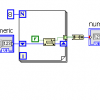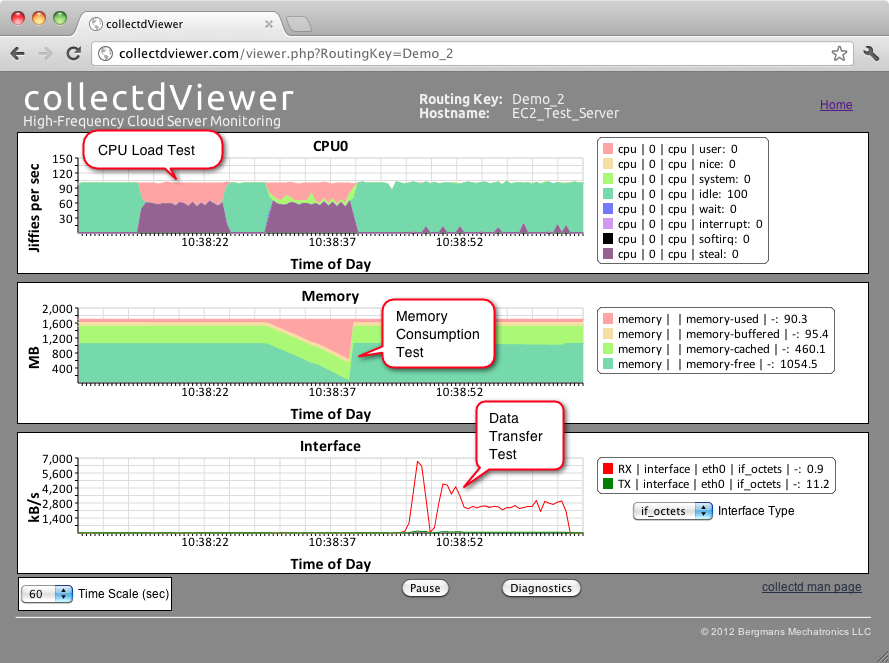Search the Community
Showing results for tags 'websocket'.
-
LabSocket enables LabVIEW applications to be easily accessed using a web browser, without the need for browser plug-ins or run-time engine on the client. The latest release of LabSocket includes support for Waveform Graphs and Charts, XY Graphs and MultiColumn ListBoxes. An option to integrate LabSocket with the Moodle CMS is available as well. A detailed User Guide and downloadable demo of this release are at: http://labsocket.com/userguide_demo.html. Below is a screenshot of a test VI (left) and its representation in a browser (right). LabSocket-RT, a special version of LabSocket for the LabVIEW Real-Time environment (eg. cRIO), is also available: http://labsocket.com/RT.html. A live demo of LabSocket-RT operating on a cRIO-9025 can be accessed at http://labsocket.com/Demo2.php, until approximately Oct 4. Other links of possible interest: Documentation on a "Remote Cascade Lab" developed by KTH Royal Institute of Technology in Sweden that uses an earlier version of LabSocket: http://www.energy.kth.se/proj/projects/Remote_labs/RL/RL_website/RCL/RCL.html Screenshots of support for MultiColumn ListBoxes: http://labsocket.com/MCLB.html Presentation to Orange County (CA) LabVIEW User Group Meeting titled "LabSocket System - Plotting Capability and Sample Applications": https://decibel.ni.com/content/docs/DOC-30313 Any questions or feedback about the system are welcome. -John Bergmans
- 10 replies
-
- 2
-

-
- remote control
- automatic web page
-
(and 1 more)
Tagged with:
-
Name: LabView <-> google maps websocket interface Submitter: Gribo Submitted: 29 Dec 2013 Category: *Uncertified* LabVIEW Version: 2012 License Type: GNU Public A simple bi-directional interface between Labview and Google maps, using Websocket. See readme.txt for instructions. Click here to download this file
-
-
Hello LAVA. Here's an idea for those interested in browser-based monitoring of cRIO-9068 performance. A few years ago I developed the collectdViewer system as a demonstration to the "DevOps" community of the benefits of using WebSockets for server monitoring. Operation of the system is quite simple conceptually: The system uses a collectd daemon (http://collectd.org) to monitor the performance parameters (eg CPU, memory, network activity) of a Linux platform. This performance data is then sent via a message broker and a WebSocket connection to a browser for display. The WebSocket connection to the browser enables a display update rate of 2x per second and as a result, it's possible to observe short transient phenomenon in the behavior of a server. For example, attached is a screenshot of collectdViewer monitoring the performance of an EC2 instance during various system load tests in a 60 second period. The high update rate also make it possible to observe phenomenon such as the network activity associated with serving a single web page or the CPU usage of the login process. Since the cRIO-9068 uses NI's Real-Time Linux operating system, it seems that it should be possible to use collectdViewer for browser-based monitoring of this platform as well. If you'd like to try the system yourself for this application, more information and a downloadable demo are available at: http://collectdviewer.com. Let me know if you need help with setting up the demo system to monitor the performance of your cRIO-9068. A few of other notes: 1) The downloadable demo of the system at the above link uses a message broker hosted on my cloud server. If there's interest in using this system for autonomously monitoring your cRIO-9068, I can create completely standalone systems for a modest fee. These systems would include a Virtual Machine that hosts an HTTP server and message broker and can run on a PC, Mac or Linux platform within your LAN. 2) The video at the following link shows the use of collectdviewer for monitoring and studying the transfer of data from the (recently defunct) Nirvanix Internet File System to an EC2 Server: http://collectdviewer.com/applications.html#monitoring_cloud_storage_data_transfer. 3) It would be feasible to incorporate the display of values of LabVIEW variables in the collectdViewer plots. One way to do this would be to use the STOMP library that I developed for the LabSocket system to send LabVIEW data to the message broker of the collectdViewer system. This idea is somewhat half-baked at this stage, but I thought I'd put it out there in case anyone had an interest in it. Any thoughts or comments are welcome. PS - Apologies for not including live hyperlinks in this post. It appears that the forum editor software is blocking these links for some reason. -John jbergmans // at bergmans // dot com
- 4 replies
-
- performance monitor
- browser
-
(and 1 more)
Tagged with:
-
WebPanel, an open-source monitoring and control framework based on Javascript, SVG, and WebSocket, is launched at Evexia. The download includes the code originally posted on the LabVIEW, WebSockets, and SVG thread with some minor script improvements and the addition of some new elements (plus removal of some old, sorry). The included LabVIEW server has been brought up to version 2011. Here is a screenshot: As with the original version, this first released version is intended as a demonstration of using Javascript+WebSocket+SVG for remote monitoring and control. Prefabricated graphical objects are imported into an SVG template using Inkscape and arranged by the user in WYSIWYG fashion. The SVG template contains the necessary elements for loading the script and using the prefab elements. As with the original version, the demo server is written in LabVIEW. I am planning an open-source server probably based on jWebSocket and Java. I am also planning on creating a WebSocket subprotocol for binary data streaming. Obviously, the project is in transition right now. If you are interested, check back often both here and at Evexia. I will try to maintain the habit of posting new release information on this thread. if you are interested in contributing, message me. I have a subversion repository set up for the project that will remain at Evexia for the time being. In the future, it will probably move to a public, open-source hosting site. sm





